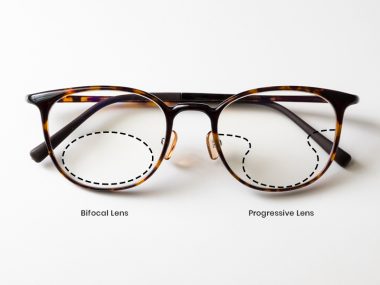Stop swapping around various glasses with different powers, and choose progressive lenses to compensate for focusing on different distances.
You are in your early 40s and started experiencing trouble focusing near objects and reading from computers or books. Maybe you need to carry your reading glasses all along with prescription glasses wherever you go. Then your eye probably desires multifocal lenses.
Though eyeglasses for presbyopia (an eye condition or refractive error that requires lenses with multiple strengths to support your near, far, and intermediate vision) come in a variety of types. These include bifocal and trifocal lenses that have visible lines across the lenses to separate different prescription areas.
Whereas Progressive lenses are a more updated version of multifocal lenses that are growing in popularity for their seamless “no-line” look.
What exactly are progressive lenses?
The no-line multifocal lenses are the pair of prescription glasses required by people to treat presbyopia and see objects at different distances clearly.
Basically known as no-line bifocal/ trifocal, they support three visual fields into the same pair of seamless glasses for viewing far-away objects, intermediate objects, and objects at distance. In real terms, they are quite adaptable and provide a more smooth transition while peeping out from different lens power.
When do you need progressive lenses?
Almost everyone undergoing treatment for presbyopia is a good candidate to wear progressive lenses. They are typically needed by adults above 40, Finding difficulty seeing up-close.
Always a mimic of natural vision and providing smooth less progression of multiple lenses, they allow the high standard vision to enjoy a broad array of activities.
Whether it is reading books, working on a computer screen, or driving a car, patients are greatly benefited from progressive lenses vs other multifocal lens options.
Benefits of progressive lenses:
- No need to swap between different glasses: Progressive lenses have three visual fields that allow you to see images at different distances with just a single pair in hand.
- Enjoy natural vision: Unlike the image jump problem experienced with bifocal and trifocal lenses, progressive lenses are known to provide natural vision. The seamless transitions between faraway and close-distance viewing avoid the uncomfortable jump associated with lenses with visible lines.
- Youthful look: Though offering multiple visual fields, progressive glasses look more like standard and normal eyeglasses. With no visible lines, they are a good alternative for children and people looking for glasses that helps them look younger.
Disadvantages of progressive lenses:
- Need time to adjust: Since progressive lenses are non-liners, a wearer needs time to learn where to peep out of lenses to see clearly. The familiarization period may offer uncomfortable vision however it resolves within 2-3 days of continuous use.
- Vision distortion during adjustment period: During the initial adjustment period, one may encounter peripheral distortion when moving the eye across different visual fields of glasses. There are instances when one may feel dizzy or nauseated when looking through the wrong section of the glasses.
- Cost is a deciding factor: The cost of progressive lenses is more than traditional bifocal and single vision lenses however, given the convenience and modern touch in its design, the price seems worth buying no liners.
Tips for Adapting to progressive lenses:
Given the different vision strengths on the same lenses, you may need time to adjust to the new pair of progressive lenses. Most people notice blurry vision, headache, nausea, and balance problems with the lens, however, they get used to them in a week or two.
Below is a quick guide on adapting to new lenses:
Wear them regularly:
Wearing the new pair of glasses full time for 4 to 5 days to perform the day-to-day tasks is the best way to adapt and train your eye for vision changes.
Don’t switch between old pairs:
If your prescription has changed recently, you may be tempted by the comfort of the old pair. But for quick adjustment, it is advised to stop using old lenses and practice new pairs as long as you can.
Move eyes instead of head to change focus:
Note that the upper part of the lens is meant for distant vision, the middle for intermediate and the lower is for close-up objects. Hence, while changing focus from (near to far, far to intermediate, or at any scale) we suggest turning your eye not your head. This will reduce symptoms such as headache and nausea due to new glasses.
View through the upper part of the lenses to climb:
When climbing stairs, people may tend to look from the bottom of their lenses. But this may cause issues with progressive lenses. Note that in progressive lenses the bottom area is meant for reading purposes whereas the upper portion is for distant moving required for stairs. Thereby make sure to look up not down the feet when climbing.
Choose the best fit eyeglasses:
With the unlimited choice available in progressive lenses, it is essential that your eyeglasses fit well and do not slide down your nose.
Use a lower lens window to read:
Make sure to hold them at a distance of 16 inches to enjoy optimum clarity and Try using the bottom portion of the lenses for reading.
Buy varifocal glasses from a reputed brand:
With several progressive lens manufacturing brands featuring the best design and styles, choosing the perfect eyeglasses can be daunting. Here, the key is to check for the budget-friendly reputed brand offering the best quality and best fit eyeglasses.
Meanwhile, you can also ask them to customize your eyewear with UV, anti-glare or anti-scratch glass coating.
To reduce the adjustment period, don’t give up on new lenses for older ones. Try putting them often to build your tolerance to vision change with a new pair. But if the problem does not resolve in a few weeks, it is always recommended to visit your eye doctor.







